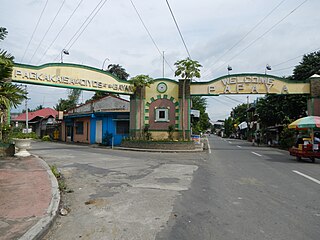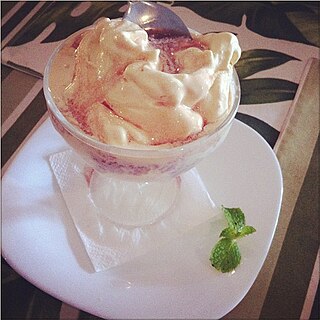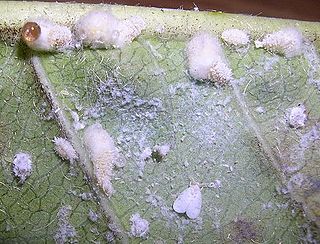Related Research Articles

The papaya, papaw, or pawpaw is the plant Carica papaya, one of the 22 accepted species in the genus Carica of the family Caricaceae. Its origin is in the tropics of the Americas, perhaps from Central America and southern Mexico.

Green papaya salad is a spicy salad made from shredded unripe papaya. Originating from ethnic Lao people, it is also eaten throughout Southeast Asia. Locally known in Thailand as som tam, in Laos as tam som or the more specific name tam maak hoong, in Cambodia as bok l'hong and in Vietnam as gỏi đu đủ.

General Tinio, officially the Municipality of General Tinio, is a 1st class municipality in the province of Nueva Ecija, Philippines. According to the 2015 census, it has a population of 47,865 people.

Creme de papaya is a Brazilian dessert. It was a culinary fad in Brazil in the mid-1990s. Nowadays, its popularity has diminished somewhat.

Oidium is a genus of Deuteromycetes, where traditionally most anamorphs of the order Erysiphales are included. Most of them are plant pathogens causing different forms of powdery mildew, for example:

The Caricaceae are a family of flowering plants in the order Brassicales, found primarily in tropical regions of Central and South America and Africa. They are usually short-lived evergreen pachycaul shrubs or small to medium-sized trees growing to 5–10 m tall. One species, Vasconcellea horovitziana is a liana and the three species of the genus Jarilla are herbs. Some species, such as the papaya, bear edible fruit and produce papain.

Phytophthora palmivora is an oomycete that causes bud-rot of palms, fruit-rot or kole-roga of coconut and areca nut. These are among the most serious diseases caused by fungi and moulds in South India. It occurs almost every year in Malnad, Mysore, North & South Kanara, Malabar and other areas. Similar diseases of palms are also known to occur in Sri Lanka, Mauritius, and Sumatra. The causative organism was first identified as Phytophthora palmivora by Edwin John Butler in 1917.

Cercospora is a genus of ascomycete fungi. Most species have no known sexual stage, and when the sexual stage is identified, it is in the genus Mycosphaerella. Most species of this genus cause plant diseases, and form leaf spots. It is a relatively well-studied genus of fungus, but there are countless species not yet described, and there is still much to learn about the best-known of the species.

Papaya ringspot virus (PRSV) is a pathogenic plant virus in the genus Potyvirus and the virus family Potyviridae which primarily infects the papaya tree.
Phyllosticta caricae-papayae is a fungal plant pathogen infecting papayas.
Phomopsis caricae-papayae is a fungal plant pathogen infecting papayas.
Phoma caricae-papayae is a fungal plant pathogen infecting papayas.

Atchara, is a pickle made from grated unripe papaya popular in the Philippines. This dish is often served as a side dish for fried or grilled foods such as pork barbecue.

Papaya, Love Goddess of the Cannibals is a 1978 Italian cannibal film directed by Joe D'Amato. It was written by Roberto Gandus and stars Melissa Chimenti in the titular role, opposite Sirpa Lane.

Paracoccus marginatus, commonly known as the papaya mealybug, is a small sap-sucking insect in the mealybug family, Pseudococcidae. It is found on a number of different hosts, including economically important tropical fruit trees and various ornamental plants.

The Scent of Green Papaya is a 1993 Vietnamese-language film produced in France by Lazennec Production, directed by Vietnamese-French director Tran Anh Hung, and starring Tran Nu Yên-Khê, Man San Lu, and Thi Loc Truong.
Papaya Bunchy Top Disease was first discovered in 1931 in Puerto Rico. Early on, the identity of the pathogen was highly contested due to the inability of isolating it; thus Koch’s postulates could not be fulfilled. Scientists have previously believed that Papaya Bunchy Top Disease was caused by a virus, a mycoplasma-like organism (MLO), or a phytoplasma, but these possible pathogens have since been disproven. Since the identity of the pathogen was unknown, all diagnoses were given solely based on a list of commonly associated symptoms. Through sequencing and microscopy, scientists identified the pathogen to be a part of the genus Rickettsia in 1996. The bacterium is described as being rod-shaped, small, gram-negative, and laticifer-inhibiting. Rickettsia causes diseases in animals, such as typhus and spotted fever, as well as in other plants, such as phony disease of peach and almond leaf scorch. Papaya Bunchy Top is found throughout the American tropics and has been economically important due to its major impact on fruit production. There is little information about the current economic impact.
Erwinia papayae is a bacteria species causing bacterial crown rot, or bacterial canker, a noteworthy and grave disease of papaya.

Ginataang manok is a Filipino chicken soup made from chicken in coconut milk with green papaya and other vegetables, garlic, ginger, onion, patis or bagoong alamang, and salt and pepper. It is a type of ginataan. A common variant of the dish adds curry powder or non-native Indian spices and is known as Filipino chicken curry.
Dangke is a type of cheese produced in South Sulawesi, Indonesia, especially in Enrekang, Baraka, Anggeraja, and Alla districts. Dangke is processed by boiling fresh buffalo milk with sliced papaya leaves, stems, or unripe papaya fruits. Dangke is typically soaked in a brine solution overnight before being wrapped with banana leaves for masking the bitter taste caused by the addition of papaya leaves.
References
- ↑ "Ovulariopsis papayae". www.mycobank.org. Retrieved 2021-01-25.